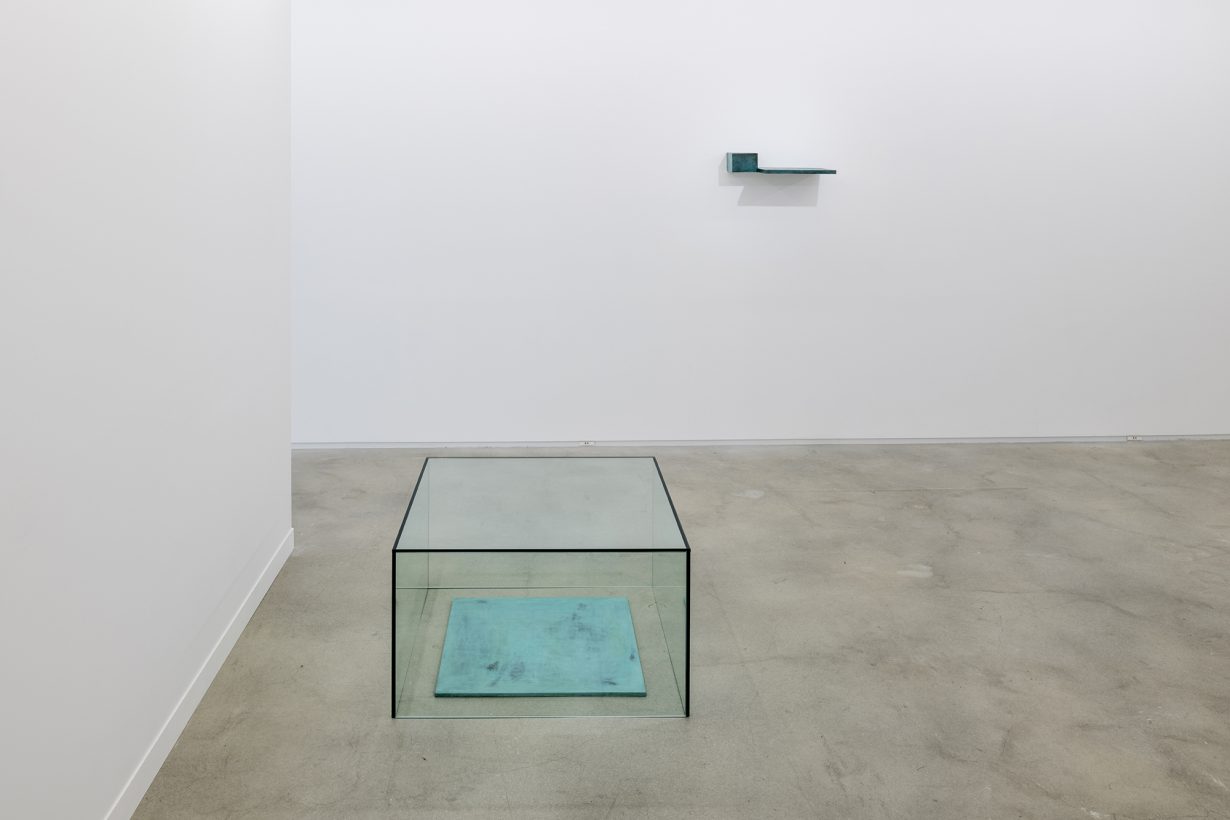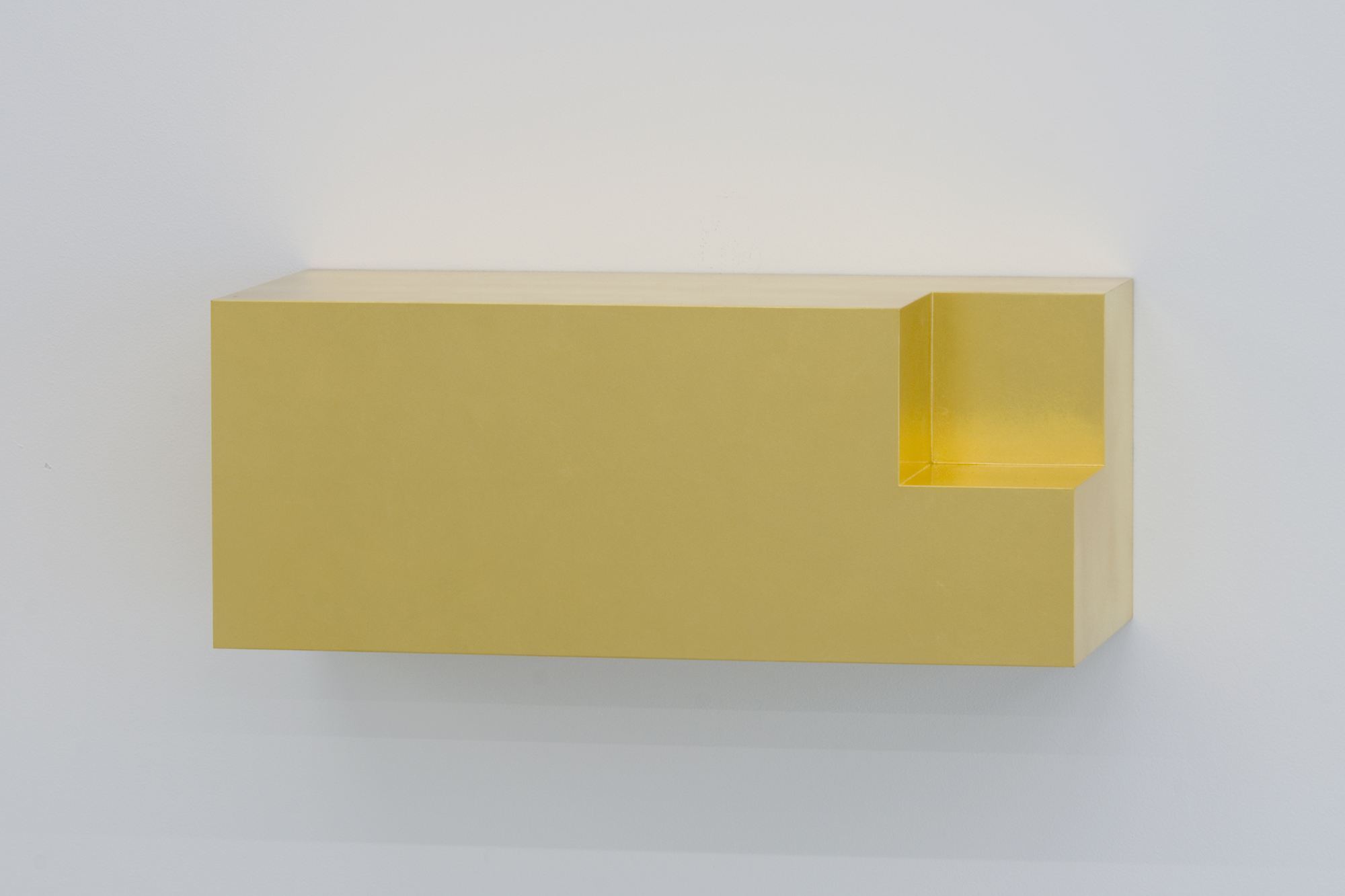If art can be made by its placement on the gallery pedestal, so too shouldn’t the pedestal be art?
Yuji Takeoka’s sculptures propose an extension, or renewal, of Marcel Duchamp’s logic: if art can be made by its placement on the gallery pedestal, so too shouldn’t the pedestal be art? A small gold protrusion from one wall, a rectangle at door-frame height, greets visitors to SCAI Piramide, casting geometric yellow reflections and mirrored grey shadows on the wall behind it, a most Juddian welcome. Takeoka has been making pedestals since 1984 and wall sculptures for longer, although several works, including this first Site Base Gold I (2024), have been made specifically for this exhibition. Takeoka’s sculptures tend to be in dialogue with their surroundings. In the next room, a work of tatamilike dimensions is mounted to the floor (Untitled, 1989), a turquoise slab of patinated copper cased in glass that seems to reference the sky-blue glass Roppongi Piramide outside, from which the gallery takes its name. The artist makes use of a range of sizes, heights and materials: Wall Pedestal (1985) is made in terracotta, with curling, leaflike decoration resembling the top of a Corinthian column. Fixed to the wall from a concealed point and positioned a metre above the floor, it creates the illusion of an invisible body, a volume that should connect the capital to its (also absent) base. Untitled (1984), a white wooden, gallery-standard pedestal, plays a simple trick: sandwiched underneath the pedestal is a disc of unidentifiable material of cobbled, uneven texture suggesting the manual labour of the artist.

In the back of the gallery, Bronze Pedestal (2012), a rectangular slab with two edges neatly curved so as to make a raised platform, is identical in shape to a kadai, a low piece of Japanese furniture used to support vases, although here in its oxidised deep green material it resembles more ancient Chinese funerary bronzes than anything one would expect of the form. (Such bronze vessels may indeed be a fitting analogue of pedestals appreciated as art.) Another, Bachi (2025), casts what looks like a traditional Japanese material – in reality Corian, masquerading as lacquerware – in an unfamiliar form, its polished red surface moulded to a perfect uniform slope, like a transmuted soup bowl or perhaps, as the word ‘bachi’ suggests, a three-stringed shamisen pick, trimmed and blown up. At the back of the room is Shadow Box Kinpaku (2006–07), a gold wall sculpture like the one that greeted us at the door, although this time covered in gold leaf, and with one cube, about 1/20th of the sculpture’s mass, removed from the front-right edge. Unlike Site Base Gold I, this sculpture, a bit below my eye level, reflects not its surroundings but itself: look into its missing section and the gold leaf shows a cube in shadow behind the missing cube, as if we can see through the sculpture and into its volumes. It is difficult to put the effect into words, because it is as if the shadows have highlighted something that shouldn’t, can’t, really be visible. This uncanny dimension – where we see some- thing invisible, feel something intangible, something that seems to be, or ought to be there – may be where Takeoka is reaching towards in his sculpture, the bare pedestal an invitation to that realm.
everything for freedom at SCAI Piramide, Tokyo, through 8 August
From the Summer 2025 issue of ArtReview Asia – get your copy.
